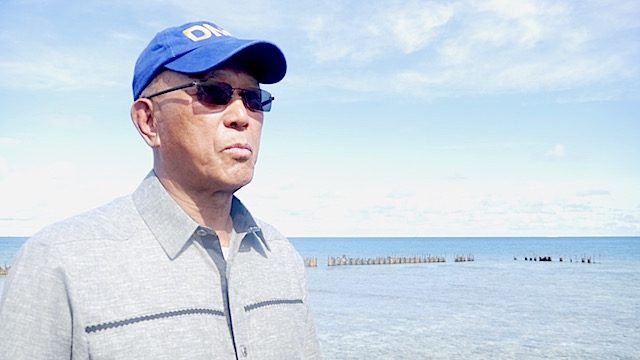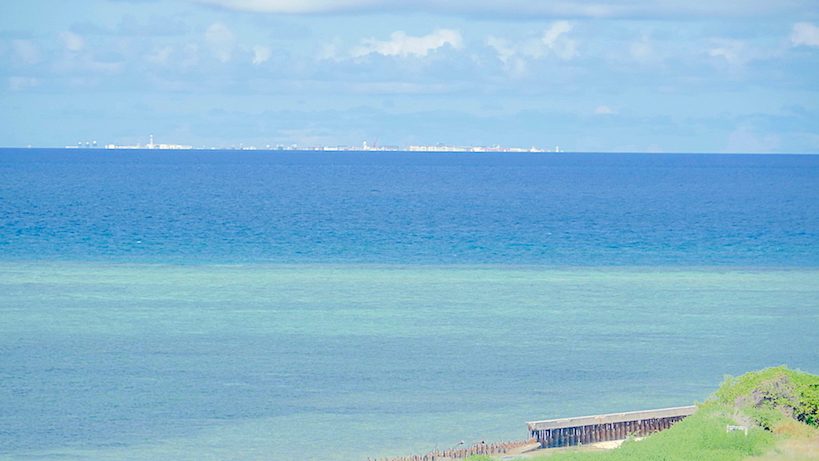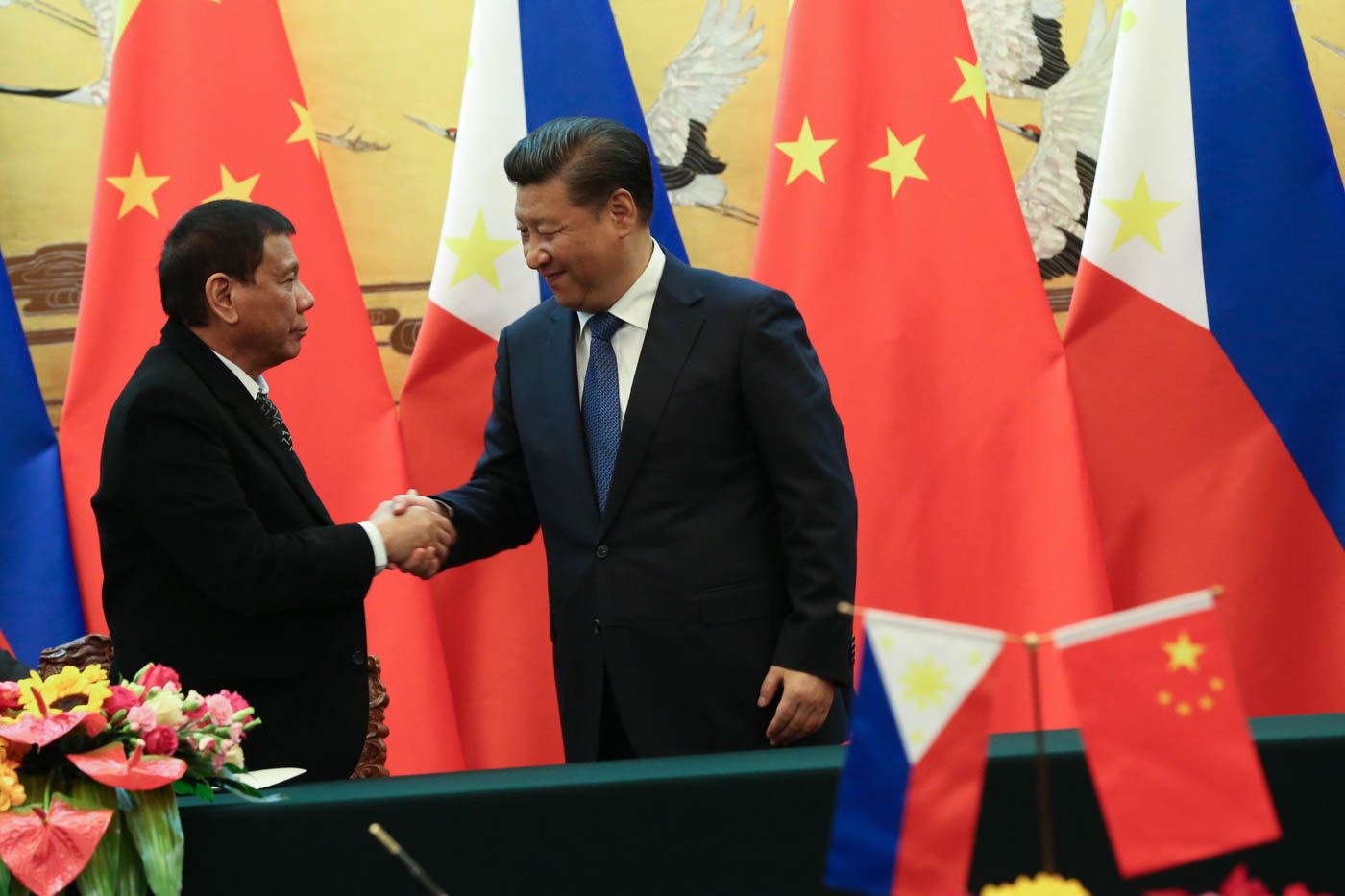SUMMARY
This is AI generated summarization, which may have errors. For context, always refer to the full article.

This story was first published on April 27, 2017 after a visit of Defense Secretary Delfin Lorenzana to Pag-asa Island.
PAG-ASA ISLAND, Philippines (UPDATED) – From the cockpit of a C130 plane of the Philippine Air Force, Defense Secretary Delfin Lorenzana saw for himself what has become of the reefs that China, and even Vietnam, turned into artificial islands. He was all the more awed by the massive facilities he previously saw only in photos reported to him.
And then he braced for the landing on the short and already eroded runway on the Philippine’s Pag-asa Island. In contrast, facilities here are sparse despite the presence of soldiers and a community of about a hundred Filipino civilians.
Here, he made a promise to the residents. The island will not be neglected anymore under President Rodrigo Duterte, he said in a speech after the flag-raising ceremony. (READ: PH military says nothing like singing nat’l anthem on Pag-asa)
“Maraming gustong ipagawa ang ating mahal na Presidente. Mayroon tayong nakalaang pera rito,” Lorenzana said. (Our beloved President wants to build a lot of facilities. We have alloted money for the island.)
Lorenzana said work should start immediately – “within the next few weeks” – to get some things done before the rainy season begins in July.
(UPDATE: China protested the plan and work was repeatedly delayed. It finally began a year later, based on satellite images published by the Asia Maritime Trasparency Initiative on May 26, 2018. China has yet to issue a public statement and security observers are pondering whether or not the Philippines will be able to finish the work.)
Strong signal to China
Lorenzana’s visit to Pag-asa, bringing along the top brass of the military, sent a strong signal that the country is not neglecting its claim over the West Philippine Sea (South China Sea).
His pronouncements also serve to test Duterte’s friendship with the most agressive claimant in the area.
A note verbale from China is expected to protest Philippine plans for Pag-asa. It can be ignored. But the Asian economic giant could do more to try to stop the plans.
What happens in the next months will show how the friendship really works.
Jay Batongbacal, director of the University of the Philippines Institute for Maritime Affairs and the Law of the Sea, expects China to talk Duterte out of these plans.
“Definitely China will call on President Duterte and try to get him to change his mind. Kung bumaliktad siya (If he makes a turnaround), then it is going to be your proof that he’ll kowtow to China. Kung hindi (If not), then that’s an indication na mukhang hindi naman siya ganoon ka-close (that the relationship is not that close),” Batongbacal told Rappler.
Protests from China prompted Duterte to back out of a plan for him to raise the Philippine flag here on June 12 for the celebration of the Philippine Independence Day.
Will Duterte give in again if China pushes to stop the plans? (READ: Duterte cancels plans to raise flag in Spratlys)
“Any change now in the plans is an indication of where that relationship really is,” Batongbacal said.
Modest plan: runway to sewage system
Pag-asa is the seat of power of the Kalayaan Group of Islands (Spratlys), consisting of 8 islands and a sandbar claimed by the Philippines. It has a town hall, a school building, a dilapidated runway, and not much else. There’s not even a pier. (READ: The residents of Pag-asa: Life on a disputed island)
On the island, Lorenzana announced a modest plan to improve facilities here a little bit. Number one, the runway. (READ: PH allots P1.6B to fast track construction on Pag-asa)
“Kanina nakakatakot mag–landing itong C130. Akala mo lalampas na sa runway dahil sa igsi ng runway,” he said. (It was a scary landing for the C130. You’d think it would overshoot the short runway.)
There is no view inside the belly of the C130 plane. But one would hear the tires upon landing – shaking wildly as it rolls over uneven earth that’s begging for badly-needed repair.

If Lorenzana’s timeline will be followed, a beach ramp will be built immediately so construction materials can be transported into the island. Everything else will be easier.
Aside from fixing the runway, Lorenzana said they will build other facilities, such as solar power tower, radio tower, desalination, plant, fish port, and a sewage facility.
“Ito lahat ‘yung ating plano, plano ng ating Presidente. Sabi rin niya, ‘Gawin na ninyo ‘yan. Huwag ‘nyo nang patagalin. Kaya kami nandito ngayon,” Lorenzana told the residents. (All these plans came from the President. He said we should get them done immediately. We should not tarry. That is why we are here.)
The previous administration had similar plans, had allocated funding, and awarded contracts for the development of Pag-asa Island. But these were deferred because they thought it was best to wait for the ruling on the country’s international arbitration case against China.
Meanwhile, China has built 3 runways on artificial islands in the South China Sea almost overnight.
The ruling of the Permanent Court of Arbitration based in The Hague came out in July 2016 when Duterte was already president. The court said China violated the Philippine’s sovereign rights, although the court did not rule on several maritime territories, such as Pag-asa and Scarborough Shoal. (READ: Highlights of the ruling: China violated Philippine sovereign rights)
“I think we could already resume at ‘yun naman ang gustong mangyari ni (and that is the plan of the) President – improve facilities here,” Lorenzana said.
Changing strategy
The Philippines occupied Pag-asa Island in the 1970s during the presidency of Ferdinand Marcos. It deployed troops here and then built a runway. But the island was neglected through the years while China grew aggressive with its claims.
“We are the last claimants here who are doing something on the islands that we are occupying. Nandito na tayo noon pang 1971. ‘Yung ating bandila naka-plant na ‘yan nun pang mga 1970s. Nauna tayo rito. ‘Yung mga iba diyan sumunod na lang,” Lorenzana said. (We’ve been heare since 1971. Our flag was planted here way back in the ’70s. We were first here. The others just followed.)
Philippine presidents from Ferdinand Marcos to Duterte have adopted various strategies to deal with China.
In 1994, China wrested control of Mischief Reef from the Philippines. The 2016 ruling said Mischief Reef is a part of the Philippines’ exclusive economic zone and is the only country that has rights to develop the maritime feature. But Mischief Reef is one of the 7 reefs that China has turned into artificial islands.
In 2012, China practically occupied Scarborough Shoal off the coast of Zambales province in Luzon. It prompted President Benigno Aquino III to file the arbitration case against China, cut communication lines, and engage in a word war with Beijing. (READ: Aquino legacy: Defying China)
Duterte has taken a different track from Aquino, shelving the arbitration ruling and instead warmed ties with China to focus on economic partnership. There have been concerns that he has become too friendly.

Former Defense Secretary Albert del Rosario warned against the bilateral track and urged the government to pursue the implementation of the arbitration ruling, saying it is the best way to protect the country’s interest.
Del Rosario said the Philippines should take advantage of its current leadership of the ASEAN to influence the regional body to integrate the ruling into the Code of Conduct. (READ: Ex-DFA chief raises questions on Duterte’s China policy)
But Lorenzana is confident with Duterte’s China policy: “We are trying to manage the issue and talk to them one on one bilaterally, settle this dispute in the South China Sea. I believe that the President is right in talking to the Chinese leadership on how to manage the issue here in South China Sea.”
The friendship has shown some gains as fishermen have been allowed back to Scarborough Shoal, although critics are worried that the country might enter into agreements that could compromise the country’s claim.
South China Sea observers are going to watch if the Philippines will proceed with its plans for Pag-asa. It offers an opportunity for Duterte to prove his critics wrong. – Rappler.com
Add a comment
How does this make you feel?
There are no comments yet. Add your comment to start the conversation.